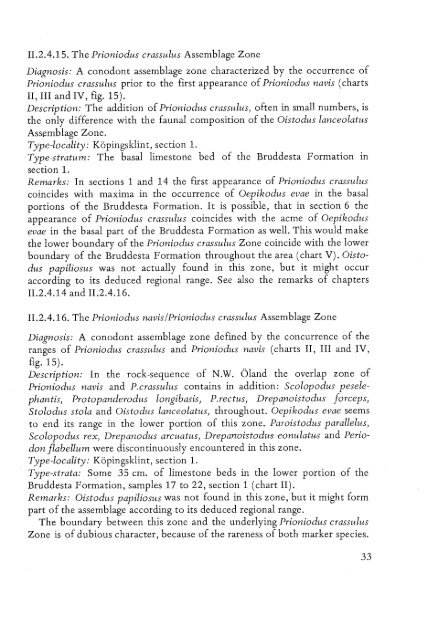UTRECHT MICROPALEONTOLOGICAL BUllETINS
UTRECHT MICROPALEONTOLOGICAL BUllETINS
UTRECHT MICROPALEONTOLOGICAL BUllETINS
You also want an ePaper? Increase the reach of your titles
YUMPU automatically turns print PDFs into web optimized ePapers that Google loves.
II.2.4.15. The Prioniodus<br />
crassulus Assemblage Zone<br />
Diagnosis: A conodont assemblage zone characterized by the occurrence of<br />
Prioniodus crassulus prior to the first appearance of Prioniodus navis (charts<br />
II, III and IV, fig. 15).<br />
Description: The addition of Prioniodus crassulus, often in small numbers, is<br />
the only difference with the faunal composition of the Oistodus lanceolatus<br />
Assemblage Zone.<br />
Type-locality: Kopingsklint, section 1.<br />
Type-stratum: The basal limestone bed of the Bruddesta Formation in<br />
section 1.<br />
Remarks: In sections 1 and 14 the first appearance of Prioniodus crassulus<br />
coincides with maxima in the occurrence of Oepikodus evae in the basal<br />
portions of the Bruddesta Formation. It is possible, that in section 6 the<br />
appearance of Prioniodus crassulus coincides with the acme of Oepikodus<br />
evae in the basal part of the Bruddesta Formation as well. This would make<br />
the lower boundary of the Prioniodus crassulus Zone coincide with the lower<br />
boundary of the Bruddesta Formation throughout the area (chart V). Oistodus<br />
papiliosus was not actually found in this zone, but it might occur<br />
according to its deduced regional range. See also the remarks of chapters<br />
II.2.4.14 and II.2.4.16.<br />
11.2.4.16. The Prioniodus navis/Prioniodus crassulus Assemblage Zone<br />
Diagnosis: A conodont assemblage zone defined by the concurrence of the<br />
ranges of Prioniodus crassulus and Prioniodus navis (charts II, III and IV,<br />
fig. 15).<br />
Description: In the rock-sequence of N.W. bland the overlap zone of<br />
Prioniodus navis and P.crassulus contains in addition: Scolopodus peselephantis,<br />
Protopanderodus longibasis, P.rectus, Drepanoistodus forceps,<br />
Stolodus stoia and Oistodus lanceolatus, throughout. Oepikodus evae seems<br />
to end its range in the lower portion of this zone. Paroistodus parallelus,<br />
Scolopodus rex, Drepanodus arcuatus, Dreparroi-stodu-s -eonulatu-s and Periodon<br />
flabellum were discontinuously encountered in this zone.<br />
Type-locality: Kopingsklint, section 1.<br />
Type-strata: Some 35 cm. of limestone beds in the lower portion of the<br />
Bruddesta Formation, samples 17 to 22, section 1 (chart II).<br />
Remarks: Oistodus papiliosus was not found in this zone, but it might form<br />
part of the assemblage according to its deduced regional range.<br />
The boundary between this zone and the underlying Prioniodus crassulus<br />
Zone is of dubious character, because of the rareness of both marker species.
















